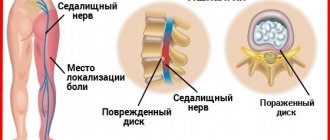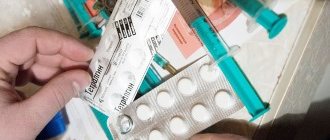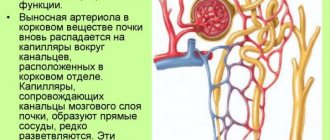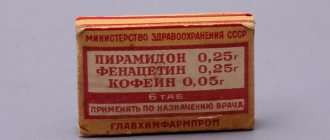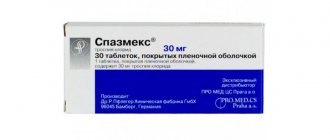Origin and history of phenobarbital
The drug "barbitul" was synthesized from barbitulic acid in 1863 and began to be used in psychiatry to calm violent patients. After 1903, when many people learned about it, phenobarbital itself was synthesized in attempts to obtain an improved version.
Currently, there are a number of drugs containing phenobarbital, as well as their analogues. Unfortunately, no matter how much innovators want to create a safe medicine for depression, insomnia or stress, side effects are subsequently discovered and addiction is discovered.
Indications for use of Phenobarbital
According to the instructions, Phenobarbital is prescribed for the treatment of:
- Focal seizures in adults and children;
- Generalized tonic-clonic seizures;
- Neurovegetative disorders;
- Encephalitis caused by mononucleosis, whooping cough, chickenpox, rubella, measles or influenza;
- Alcohol withdrawal;
- Tremors, convulsions of various origins, agitation, fear, anxiety, tension, insomnia;
- Chronic intrahepatic cholestasis;
- Hyperbilirubinemia, including congenital non-hemolytic conjugated;
- Spasms of peripheral arteries and spastic paralysis;
- Epilepsy.
Effects of phenobarbital on the body and overdose
Scientifically speaking, the substance affects the nervous system and brain, leading to a sedative-hypnotic effect. But to put it simply, any drug, including this one, acts on the body in a certain way depending on the size of the dose:
- a small dose stimulates;
- an average dose leads to lethargy and drowsiness;
- a large dose is lethal.
In addition, any such substance leaches essential vitamins and minerals from the body, and their lack leads to poor health, poor functioning of internal organs, decreased immunity and the development of a number of diseases.
With uncontrolled use of phenobarbital as a drug, an overdose is possible; a fatal dose can be a tablet washed down with alcohol or taken together with other depressants. Taking several tablets in a row can also lead to an overdose due to the fact that the drug takes a long time to be eliminated from the body. Death occurs due to swelling of the brain and lungs, circulatory and respiratory problems. And that's not all the dangers of phenobarbital.
If this medicine is taken by a healthy person who does not abuse alcohol and drugs, the effect will be strong - he will sleep for about a day and then it will be difficult to “go away”.
The dose of the drug that produces a narcotic effect is slightly below the lethal dose.
Symptoms of phenobarbital poisoning are as follows:
- nausea, vomiting;
- dizziness;
- pain in the eyes;
- drooling and snot begin to flow intensively;
- breathing is rare and intermittent.
The person begins to fall asleep, and hallucinations may appear. Then he loses consciousness, his body temperature rises, and this can result in paralysis and death due to complete cessation of breathing. It is important to quickly recognize the symptoms of poisoning and call an ambulance. Before the doctors arrive, you must:
- rinse the stomach several times with plenty of water, inducing vomiting;
- give activated charcoal to drink, then rinse the stomach again;
- Give Glauber's salt to drink (it will help remove the drug from the body);
- give a lot to drink (strong tea or coffee) and give a diuretic (laxatives are not recommended);
- if the person is unconscious, perform chest compressions and artificial respiration. At the same time, make sure that the tongue does not fall into the throat; to do this, you need to put the victim on his side.
The harm from phenobarbital does not end there, since day after day it has a negative effect on the body, destroying vitamins, minerals, organs and tissues.
Over and over again, it is not completely eliminated, but is deposited in adipose tissue, causing negative reactions (fatigue, lethargy, dullness, pain, etc.) when tiny particles from adipose tissue enter the blood again, for example, during stress, exercise or hunger. That is, the question is not how much phenobarbital is removed from the body, since part of it will remain in the body forever. The question is what to do to cleanse the body of drug deposits and medications.
Overdose
With a single dose of one gram of the drug Phenobarbital, the following symptoms are observed: lethargy, nystagmus, dizziness, headache, decrease or increase in body temperature, blurred speech, irritability, loss or weakening of reflexes, sleep disturbances, difficulty and slowing of breathing, coma, ataxia, decreased blood pressure , brady- or tachycardia, pneumonia, confusion, pulmonary edema, oliguria, constriction of the pupils. In these cases, symptomatic therapy is necessary.
When taking from 2 to 10 g of the drug Phenobarbital, it is fatal.
How does dependence on phenobarbital occur?
Psychiatrist-narcologist Minicheva I. speaks about this: “Almost every drug that acts on the central nervous system is a drug, as it leads to mental and then physical dependence. And it all starts with increasing the dose - the previous one “doesn’t take” and “doesn’t catch on.” ... Habituation and dependence on phenobarbital develops within 2-3 weeks of regular use.” And then the drug addict does not care how much phenobarbital costs and that it is a sleeping pill.
Minicheva also warns: “Do not take medications without a doctor’s prescription! Separately, I would like to address drivers and driver candidates: almost no one knows that phenobarbital is contained in Corvalol and Valocordin, which are not usually considered sleeping pills. Often, a person, having taken Corvalol or Valocordin, gets behind the wheel without fear.”
Doctors’ reviews of phenobarbital also speak of addiction: “it’s addictive,” “causes quite serious impairments in memory and concentration,” and “a lot of severe side effects.”
Substance-powder Phenobarbital (Phenobarbitalum)
Instructions for medical use of the drug
Description of pharmacological action
Belongs to the group of barbiturates. It interacts with the “barbiturate” portion of the benzodiazepine-GABA receptor complex, thereby increasing the sensitivity of GABA receptors to GABA, leading to the opening of neuronal channels for chlorine ions, which leads to an increase in their entry into the cell. Reduces the excitability of neurons in the epileptogenic focus and the propagation of nerve impulses. Shows antagonism towards a number of excitatory mediators (glutamate and others). Suppresses the sensory zones of the cerebral cortex, reduces motor activity, and inhibits cerebral functions, including the respiratory center. Does not have a significant effect on the cardiovascular system. Reduces the tone of the smooth muscles of the gastrointestinal tract. In small doses, it somewhat reduces the intensity of metabolic processes, which may manifest itself as slight hypothermia. It has anticonvulsant, sedative (in small doses), hypnotic, antihyperbilirubinemic, muscle relaxant and antispasmodic effects. Being an inducer of microsomal oxidation enzymes in the liver, it increases its detoxification function and reduces the concentration of bilirubin in the blood serum.
Indications for use
- epilepsy (all types of seizures except absences), seizures of non-epileptic origin; - chorea; - spastic paralysis; - sleep disturbances, agitation, anxiety, fear.
Release form
substance-powder; paper bag (bag) 15 kg; substance-powder; polyethylene double-ball bag (bag) 25 kg, fiber drum 1; substance-powder; double ball polyethylene bag 25 kg, drum 1; substance-powder; paper bag (bag) 5 kg; substance-powder; paper bag (bag) 10 kg; substance-powder; double-layer polyethylene bag (bag) 5 kg, fiber drum 1; substance-powder; double-layer polyethylene bag (bag) 10 kg, fiber drum 1; substance-powder; double-layer polyethylene bag (bag) 15 kg, fiber drum 1; substance-powder; double-layer polyethylene bag (bag) 25 kg, fiber drum 1; substance-powder; double-ball polyethylene bag 20 kg, drum 1;
Pharmacodynamics
Be included in the group of barbiturates. Interaction with the “barbiturate” part of the benzodiazepine-GABA receptor complex, which increases the sensitivity of GABA receptors to GABA, leads to the opening of neuronal channels for chlorine ions, which leads to an increase in them going to the closet. Reduces the excitability of epileptogenic neurons and increases nerve impulses. It antagonizes a number of excitatory mediators (glutamate and others). It suppresses the sensory zones of the cerebral cortex, changes motor activity, suppresses cerebral functions, including the respiratory center. Do not force the flow of energy into the cardiac-vascular system. Reduces the tone of the smooth muscles of the GCT. In small doses, the drops change the intensity of metabolic processes, which may manifest as mild hypothermia. Volodya has anti-dominant, sedative (in small doses), analgesic, antihyperbolic rubinemic, muscle relaxant and antispasmodic action. Being an inducer of microsomal oxidation enzymes in the liver, it promotes its detoxification function and reduces the concentration of bilerubin in the blood serum.
Pharmacokinetics
When taken in the middle, it will be thoroughly absorbed. Cmax in blood plasma is determined after 1-2 years, binding to plasma proteins - 50%, in newborns - 30-40%. Metabolized in the liver, inducing microsomal liver enzymes CYP3A4, CYP3A5, CYP3A7 (the speed of enzymatic reactions increases 10-12 times). Cumulates in the body. T1 / 2 folds 2-4 dibs. It is excreted in the form of glucuronide, about 25% in the unchanged form. Milk penetrates into the breast and through the placental barrier.
Use during pregnancy
Contraindications for gestation and lactation.
Use for renal impairment
Contraindications for cases of nitric deficiency.
Other special occasions at reception
Contraindications for cases of hepatic insufficiency.
Contraindications for use
— Viral pechenkova and/or nirkova deficiency; — Medical neglect (including in the anamnesis); — Hyperkinesis; — Myasthenia; - Severe anemia; - Porphyria; - blood diabetes; — Hypofunction of the supra-neural veins; — Hyperthyroidism; - Depression; — Broncho-obstructive illness; — Active alcoholism; — Vagility and lactation period; — Children's age (due to the impossibility of precise dosing); - Hypersensitivity to any of the components of the drug. With caution: in weakened patients (a high risk of paradoxical awakening, depression and confusion occurs when taking large doses).
Side effects
On the side of the nervous system: asthenia, confusion, mental weakness, ataxia, nystagmus, paradoxical reaction (especially in summer and weakened patients - awakening), hallucinations, depression, “nightmarish” dreams, sleep disturbances, inkope. On the side of the musculoskeletal system: with severe congestion - impaired osteogenesis and the development of rickets. On the side of the herbal system: boredom, vomiting, constipation, with severe congestion - impaired liver function. On the side of the hematopoietic organs: agranulocytosis, megaloblastic anemia, thrombocytopenia. On the side of the cardiovascular system: decreased arterial pressure. Allergic reactions: skin rash, pimples, swelling of the forehead, face and lips, difficulty breathing, rarely - exfoliative dermatitis, severe exudative erythema (Stevens-Johnson syndrome). Others: in case of dry stagnation - medicinal storage.
Interactions with other drugs
Phenytoin and valproate are used instead of phenobarbital in blood serum. The anti-drug effect of phenobarbital decreases when taken simultaneously with reserpine, and increases when taken with amitriptyline, nialamide, diazepam, chlordiazepoxide. Reduces the effectiveness of oral contraceptives and salicylates. Reduces blood levels of indirect angiocoagulants, glucocorticosteroids, griseofulvin, doxycycline, estrogens and other drugs that are metabolized in the liver through oxidation (accelerates their ynuvannya). Resistant to alcohol, neuroleptics, narcotic analgesics, muscle relaxants, sedatives and analgesics. Acetazolamide, a potent agent, reduces the reabsorption of phenobarbital in drugs and weakens its effect. The potent effect of phenobarbital is reduced when taken simultaneously with atropine, belladonna extract, dextrose, thiamine, nicotinic acid, analgesics and psychostimulant drugs. Reduces the antibacterial activity of antibiotics and sulfonamides, the antifungal activity of griseofulvin.
Precautions for use
If dental problems occur, take phenobarbital. Hypersensitivity reactions are more likely to intensify when there is a history of frequent hand squeezing, shaking hands, progressive weakness, confusion, impaired vision, boredom, vomiting, sleep disturbance, orthostatic hypotension (confusion, inability to languid camp). In severe cases, more significant symptoms (seizure, delirium) may occur over a period of 16 years and last up to 5 days after a sudden shift. The severity of the seizure syndrome gradually decreases over a period of approximately 15 days. The risk of developing delirium and a trial with a possible fatal result is greater with a sharp dose after a severe illness in people with medical conditions. Raptov's use in epilepsy can lead to a seizure or status epilepticus. When phenobarbital is administered for the treatment of epilepsy, it is recommended to monitor its level in the blood. When undergoing treatment, it is necessary to periodically measure the concentration of folate in the blood, monitor the peripheral blood pattern, liver function and blood levels. If it is necessary to use barbiturates during bedtime, it is recommended to take bedsheets in readiness for resuscitation. Drinking alcoholic beverages is unacceptable during the holiday period. Do not stagnate during the hour of work for drivers of transport vehicles and people, whose activities require a strong mental and physical reaction, and are also associated with an increased concentration of respect.
Special instructions for use
The uniqueness of the drug's long-term stagnation is due to the possibility of its cumulation in the body and development of the drug. To avoid the development of the “wake-up” syndrome (headaches, “nightmare” dreams, drowsiness and/or insomnia), take medication step by step. During the bathing hour, it is not recommended to use a car, as well as to engage in activities that require the speed of psychomotor reactions.
Storage conditions
In dry, protected from light conditions.
Best before date
60 months
ATX classification:
N Nervous system
N03 Antiepileptic drugs
N03A Antiepileptic drugs
N03AA Barbiturates and their derivatives
N03AA02 Phenobarbital
Signs of phenobarbital use
Those who use this “sleeping pill” will be given the following signs:
- fatigue;
- drowsiness;
- inattention;
- the person seems distant;
- no interest in what is happening around;
- inappropriate reactions;
- outbursts of aggression or anger;
- difficult to make decisions.
Getting rid of dependence on phenobarbital and drugs containing it
Whatever a person takes - phenobarbital, alcohol or drugs, he can be saved from addiction with the help of the Narconon program, which combines:
- special exercises that allow a person to begin to face life again and feel comfortable in existing circumstances;
- undergoing a special detoxification program (non-medical), which allows you to remove the remains of drugs and medications from the body;
- obtaining useful knowledge and skills that allow you to solve problems and build your life;
- finding and resolving the problems that caused the addiction.
Contact us to help yourself or a loved one escape the grips of addiction and start living a fulfilling and happy life again.
Share:
Promedol
Lemoran - medicine or drug
Method of use of the drug
Phenobarbital is taken orally. It is completely, but very slowly absorbed. The highest concentrations in the blood are observed approximately 1 to 2 hours after administration. About 50% is bound by plasma proteins. The medication is evenly distributed in different organs and tissues. Contraindications
Hypersensitivity, a history of manifest or latent porphyria, severe anemia, respiratory diseases accompanied by shortness of breath or airway obstruction, liver and/or renal failure, myasthenia gravis, alcoholism, drug or drug addiction, pregnancy (especially the first trimester), breastfeeding.
Newborns
For newborns, this remedy can be used in case of hemolytic disease . It increases the detoxification the liver and reduces serum bilirubin .
If mothers use the drug in the last trimester of pregnancy, for newborns this is fraught with the development of physical dependence on the drug and withdrawal syndrome , up to acute withdrawal syndrome , which manifests itself as epileptic seizures and increased excitability immediately after birth or during the first couple of weeks.
Use during childbirth in some cases causes respiratory depression in the infant, especially in premature infants.
Taking this drug as an anticonvulsant during pregnancy can cause bleeding in the baby in the first days after birth.
Effect on humans of Phenobarbital used in high doses
An overdose of the drug causes serious harm to health. There are disruptions in the transmission of nerve impulses, and consciousness changes. The most dangerous complication is destruction and damage to the main nerve canals. With this pathology, symptoms such as:
- psychomotor excitability;
- inability to remain calm or sit still for even a short time;
- sense of anxiety.
If a person takes the drug in high doses for a long time, his nerve channels completely atrophy. But nerve impulses continue to look for a way out, so they pass along alternative courses of movement. As a result, the addict:
- involuntary contractions of the facial muscles occur (facial expressions look very strange);
- the tongue falls out;
- there is copious secretion of saliva;
- tremor of the fingers is observed.
The effect of Phenobarbital on the human body is very specific. In many drug addicts, the respiratory center is depressed. They begin to inhale less air. There is a feeling of lack of oxygen. Choking may develop.
Drug poisoning can be acute or chronic. A specific toxic dose for humans has not been established. It depends on age, gender, body weight, and health status. If you drink one gram of medication at a time, symptoms of acute intoxication will most likely appear.
The lethal dose of Phenobarbital is from two to ten grams. An addict develops symptoms reminiscent of alcohol poisoning:
- vomit;
- nausea;
- dizziness;
- stomach ache;
- severe headaches;
- problems with orientation in space;
- surges in blood pressure.
Signs of a neurological disorder also make themselves felt. Therefore, if a dose of Phenobarbital exceeding one gram is taken, you should receive qualified medical care as soon as possible.
Release form and composition
Phenobarbital is available in the following forms:
- tablets: flat-cylindrical, round, chamfered, white (6 pcs. or 10 pcs. in blister or blister-free packages; in a cardboard pack there are 1, 2 or 5 blister or blister-free packages);
- tablets for children: flat-cylindrical, white, with a bevel (dosage 5 mg) or with a bevel and a score (dosage 50 mg) (10 pieces in blister packs, 1 or 2 blister packs in a cardboard pack).
Composition of 1 tablet:
- active ingredient: phenobarbital – 50 mg or 100 mg;
- auxiliary components: potato starch, sucrose, talc, stearic acid.
Composition of 1 tablet for children:
- active ingredient: phenobarbital – 5 mg or 50 mg;
- auxiliary components: potato starch, sucrose, calcium stearate.
Side effects
Adverse reactions are most often observed with long-term use of the drug. As a rule, this is inhibition of central nervous system activity, allergies , and a pronounced decrease in blood pressure . In addition, agranulocytosis , headache , calcium metabolism disorders, thrombocytopenia , vascular collapse , megaloblastic anemia , bradycardia , nausea, constipation , vomiting, folate , osteomalacia, impotence , hypocalcemia , impaired libido are possible.
List
There are a large number of anticonvulsant medications used for epilepsy. These include the following:
Phenobarbital (Luminal) has been used as an anticonvulsant for epilepsy since 1911. Can be used for all types of seizures other than absences. The dosage is 0.2-0.6 g/day.
It is worth noting that now this medication is not so popular due to the large number of adverse reactions. Among them, insomnia, rash, the occurrence of involuntary movements, decreased blood pressure and cognitive functions, toxic effects on the liver, aggression, and depression are possible.
Contraindications include alcohol and drug addiction, myasthenia gravis, serious liver and kidney diseases, diabetes mellitus, severe anemia, pregnancy, and obstructive pulmonary diseases. Depakaine. Available in different dosage forms. There are also a large number of other drugs with the same active substance: Valproic acid, Calcium and sodium valproate, Convulex and others.
The drug is a first-line drug and is used to treat almost any seizure, both generalized and partial.
The advantage of the medication is that it does not have a negative effect on any attacks, that is, even if it is not effective, it will not lead to an increase in their frequency.
The dosage is 15-20 mg/kg/day. When taken, there may be a negative effect on the liver, weight gain, bleeding disorders, nausea, vomiting, digestive disorders, and drowsiness. The drug should not be prescribed to children under 6 years of age.
Carbamazepine. Treatment of secondary generalized and partial seizures often begins with this remedy. It is not prescribed for myoclonic attacks and absence seizures. The dosage is 10-20 mg/kg, although it may increase.
In addition to the anticonvulsant effect, it also has an antipsychotic effect, which makes it especially useful for patients with concomitant mental disorders. Allowed for children over one year old. Oxcarbazepine (Trileptal). second generation drug Carbamazepine, which is also used for generalized and partial seizures. The treatment regimen is also similar.
Moreover, in comparison with the previous one, this drug has a lot of advantages. It is better tolerated, has fewer side effects, is less likely to provoke allergic reactions, and does not require dosage adjustment.
Can be prescribed to children older than one month. In addition, it interacts less with other drugs, so if complex therapy is required, it is often prescribed.
The drugs are available with a prescription.
How to understand that a person is “sitting” on Phenobarbital
You can recognize an addict by the following symptoms:
- detached look;
- complete lack of initiative;
- inability to focus on anything;
- lack of interest in what is happening around;
- constant drowsiness;
- excessive timidity;
- inadequacy and aggression towards relatives and friends.
Of course, all these signs are vague and non-specific. Therefore, if relatives do not know what medicine the addict is taking, they most likely will not guess anything. If they are aware of recent treatment with Phenobarbital, then they should think about the fact that the addict is continuing therapy without the knowledge of the doctor.
